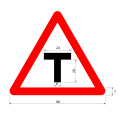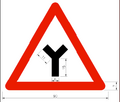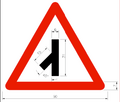Three-way junction
This article needs additional citations for verification. (October 2006) |

A 3-way junction (or 3-way intersection) is a type of road junction with three arms. A Y junction (or Y intersection) generally has 3 arms of equal size. A T junction (or T intersection) also has 3 arms, but one of the arms is generally a minor road connecting to larger road.
Some T junctions are controlled by traffic lights, but others rely upon drivers to obey right-of-way rules. For example, a vehicle travelling on the major roads of the "T" typically has right-of-way, meaning that the vehicle approaching the "major" road must allow it to pass before joining the flow of traffic.
An experiment was done in Illinois, United States to allow going straight on red (like a right turn on red) when approaching a T junction on the main road, with the intersecting road on the left. It was a failure. However, at some T junctions where the main road includes at least two lanes on the side away from the intersecting road, the farthest (rightmost, in areas where traffic drives to the right) lane is given the right of way to proceed straight through the intersection at all times, denoted by a "green arrow" signal if a traffic light is installed at the intersection. In such cases, often that lane is also specially delimited with pavement markings or other lane separation devices, to keep left-turning traffic on the intersecting road from colliding with traffic proceeding through the intersection on the main road. There are now safer variations of this, called Continuous T-intersections, that have a left-exit off of the main road to completely separate those going straight, which allows for a traffic signal on only one side of the road.[1]
In the People's Republic of China, going straight on red when approaching a T junction on the main road with the intersecting road on the left was permitted until outlawed by the Road Traffic Safety Law of the People's Republic of China effective on 1 May 2004.
In Taiwan administered by the Republic of China, when at least two vehicles reach a T intersection without a working traffic light, the vehicle on the side road is to yield to any other vehicle straight on the main road. If two vehicles want to turn left, the vehicle on the left is to yield.[2]
Image gallery
-
T Intersection Sign in Taiwan with no more road straight ahead
-
T Intersection Sign in Taiwan with side road on the left
-
T Intersection Sign in Taiwan with side road on the right
-
Y Intersection Sign in Taiwan
-
3-way Intersection Sign in Taiwan with side road on the right but not right angle
-
3-way Intersection Sign in Taiwan with side road on the left but not right angle
References
- ^ An Applied Technology and Traffic Analysis Program ([1])
- ^ Clause 2 of Section 1 of Article 102 of the Road Traffic Security Rules (s:zh:道路交通安全規則)






